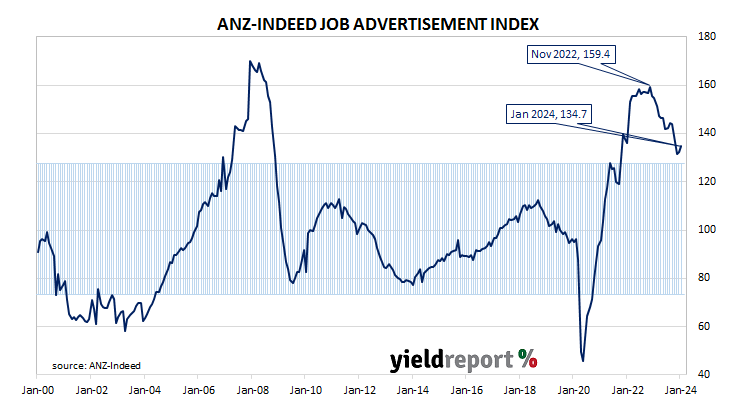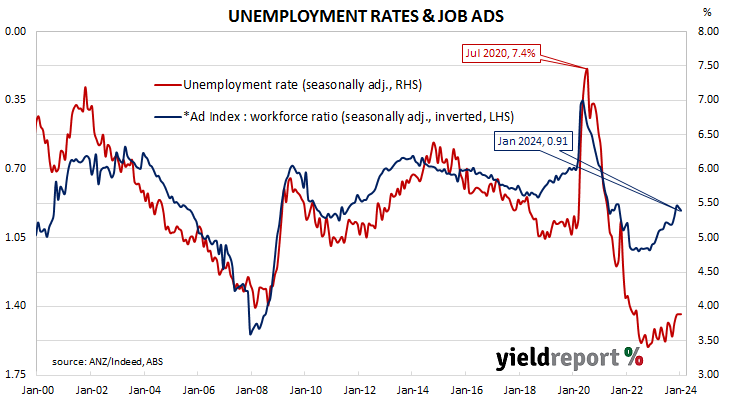Summary: Job ads up 1.7% in January; 14.7% lower than January 2023; ANZ: stabilisation at still-elevated level highlights labour market resilience; ACGB yields rise sharply; rate-cut expectations soften; ad index-to-workforce ratio ticks up.
From mid-2017 onwards, year-on-year growth rates in the total number of Australian job advertisements consistently exceeded 10%. That was until mid-2018 when the annual growth rate fell back markedly. 2019 was notable for its reduced employment advertising and this trend continued into the first quarter of 2020. Advertising then plunged in April and May of 2020 as pandemic restrictions took effect but recovered quite quickly, reaching historically-high levels in 2022.
According to the latest ANZ-Indeed figures, total advertisements rose by 1.7% in January on a seasonally adjusted basis. The result followed a gain of 0.7% in December and a loss of 5.3% in November. On a 12-month basis, total job advertisements were 13.0% lower than in January 2023, up from December’s revised figure of -14.7%.
“ANZ-Indeed Job Ads has risen 2.3% over the past two months, following a steady decline over the previous 12 months,” said ANZ economist Madeline Dunk. “This stabilisation at a still-elevated level highlights the labour market’s resilience. There is no doubt the labour market is cooling, but we do not expect to see a significant downturn anytime soon.”
Commonwealth Government bond yields rose sharply on the day following similar movements of US Treasury yields on Friday night. By the close of business, the 3-year ACGB yields had gained 13bps to 3.65%, the 10-year yield had added 12bps to 4.11% while the 20-year yield finished 10bps higher at 4.41%.
In the cash futures market, expectations regarding rate cuts later this year softened. At the end of the day, contracts implied the cash rate would remain close to the current rate for the next few months and average 4.305% through March, 4.285% in April and 4.25% in May. However, August contracts implied a 4.095% average cash rate while November contracts implied 3.90%, 43bps less than the current rate.
The inverse relationship between job advertisements and the unemployment rate has been quite strong (see below chart), although ANZ themselves called the relationship between the two series into question in early 2019. A higher job advertisement index as a proportion of the labour force is suggestive of lower unemployment rates in the near future while a lower ratio suggests higher unemployment rates will follow. January’s ad index-to-workforce ratio inched up from 0.90 to 0.91 after revisions.
In 2008/2009, advertisements plummeted and Australia’s unemployment rate jumped from 4% to nearly 6% over a period of 15 months. When a more dramatic fall in advertisements took place in April 2020, the unemployment rate responded much more quickly.



